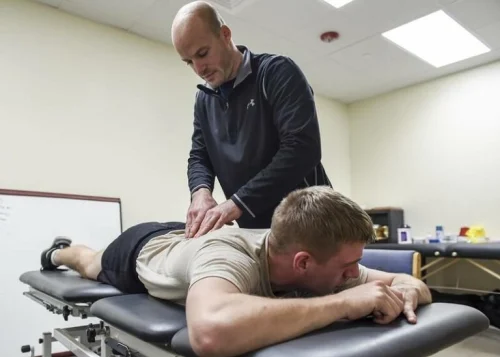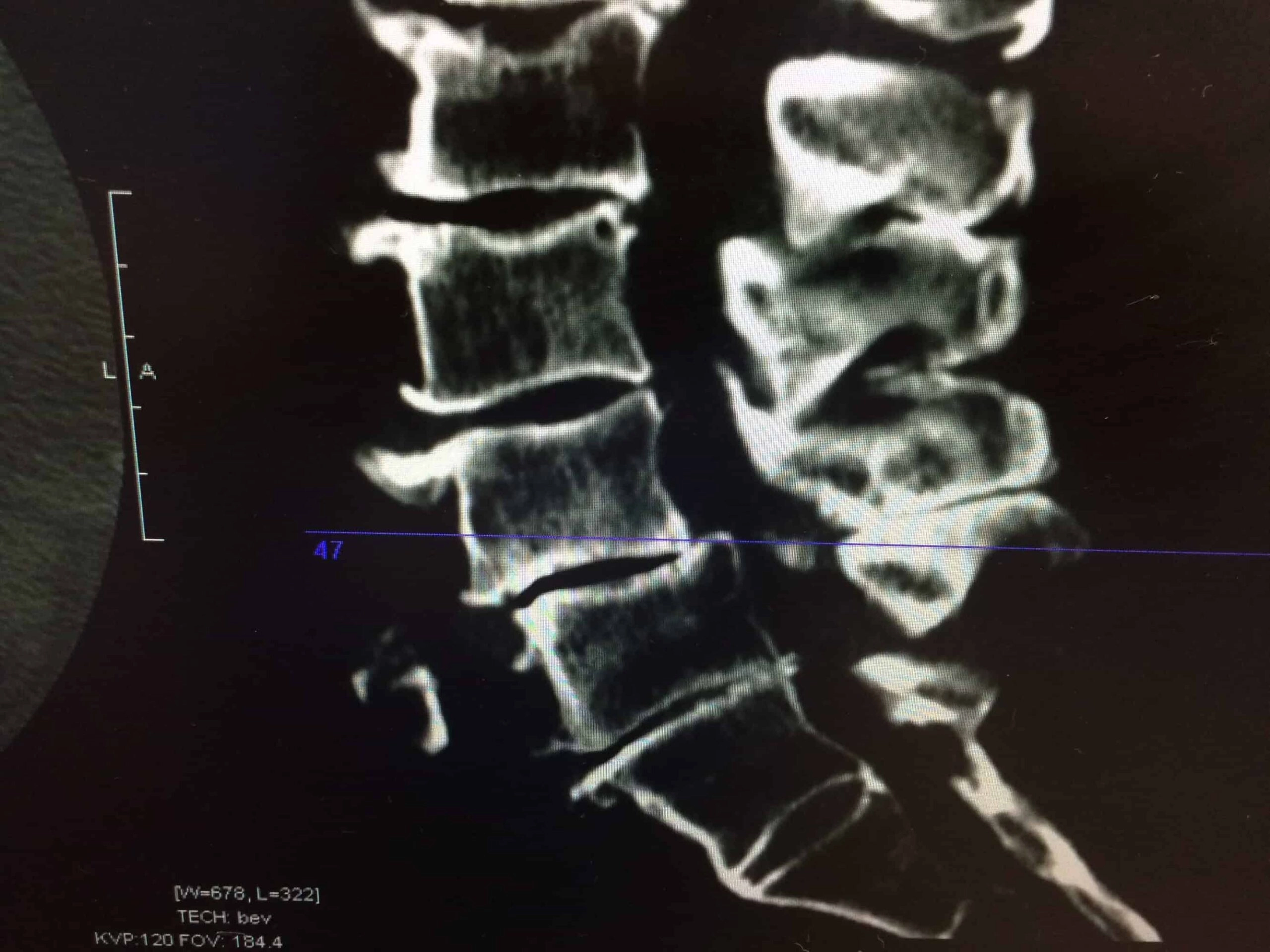Spondylolisthesis happens when one vertebra slips out over the one below it. When this does cause symptoms, they are usually back and leg pain. Some severe cases can cause other, more serious issues. Regardless of whether your spondylolisthesis is causing you pain, it’s important to seek proper conservative care from an Anchorage chiropractor or other medical professional.
Most spondylolisthesis cases can be cured naturally. In fact, the vast majority of spondylolisthesis patients should seek natural, conservative care before they even consider surgery. Not only are natural options better suited for most people, but they’re also safer and non-invasive. But not all-natural options are equal.
There are a whole host of treatment options available to patients suffering from spondylolisthesis. Not all options will be suited for every individual – which is why treatment plans developed by chiropractors, physical therapists, and other medical professionals must be and are tailored to the specific individual’s needs.
Two common options for treatment, often tried before any others, are:
- Rest – refrain from physically stressful activities like lifting, bending, etc…
- Ice Therapy – apply cold packs on and off to reduce inflammation
Other natural treatment options include:
Posture Correction
Developing a good posture is a great way to fight back against spondylolisthesis. You can do this by:
- Paying mind to it – if you notice you are slouching or sitting incorrectly, correct it.
- Build your core – the right exercises and stretches can strengthen your core and help make maintaining your posture all the easier. A physical therapist or chiropractor can give you specific direction here.
- Chiropractic care – chiropractic adjustments, provided by your local Anchorage chiropractor, are an excellent tool to correct spinal misalignments. Such misalignments can wreak havoc on your posture, if not corrected..
As far as spondylolisthesis is concerned, good posture can reduce strain on your spine and prevent more slippage.
Bracing
A brace can reduce pain by artificially supporting the spine. It can be helpful for people suffering from spondylolisthesis or other issues involving unusual structures, curves, or protrusions in the spine. Medical braces can be custom-fit.
Chiropractic Care in Anchorage, AK
Chiropractors are experts in the musculoskeletal system which makes them an excellent option for people suffering from spondylolisthesis. One of their most effective tools is a spinal adjustment.
This involves your Anchorage-based chiropractor placing his hands on the individual’s back and applying controlled pressure to “pop” joints and manipulate the vertebrae in the spine. Over the long term, a chiropractor may be able to slip the problem vertebra back into the position in which it belongs.
In the meantime, of course, chiropractors have a number of other tools at their disposal that can be used to alleviate symptoms like stiffness, pain, or difficulty bending. They can also serve to prevent further degeneration. These tools include:
- Spinal manipulation – ranges over the whole spine to provide short-term relief
- Spinal adjustment (noted above) – targets a specific area of the spine to provide long-term gains (i.e. shifting the vertebra back)
- Low-Force Chiropractic Manipulation a gentle form of chiropractic manipulation designed with “fragile” individuals in mind (the elderly, recent accident victims, etc….).
- Flexion-distraction techniques – This is a specially designed table to gently stretch the spine to relieve pressure and pain. It works by effectively decompressing the spinal joints that are the source of the issue.
Physical Therapy
Physical therapy is another non-invasive natural form of treatment for spondylolisthesis. Not unlike chiropractors, physical therapists (PTs) are well-versed in the operation and treatment of muscles in the human body. They use a combination of stretching and exercise to target and build specific muscles and muscle groups.
In the case of spondylolisthesis, PTs target the muscles in the lower back, around the spine, the buttocks, and the hamstrings. Effectively implemented, physical therapy can improve flexibility and improve the posture and support of the spine.
Home Exercises Recommended by Your Anchorage, AK Chiropractor
A regular exercise routine is another great way to cope with spondylolisthesis. Properly utilized, it can prevent spondylolisthesis from developing, getting worse, or coming back.
Of course, there are good exercises and bad exercises. For example, you should avoid heavy-duty exercise like football, running, or weightlifting. All those are simply too strenuous for a condition as delicate as spondylolisthesis.
A competent, qualified medical professional like a chiropractor or physical therapist can help you sort through the best exercises for your condition. However, here is a short list of just some of the many options you may have presented before you:
General Exercises
- Walking – a low impact way to retain muscular strength and joint mobility. If necessary, start with short walks and build from there (mind posture and form as you walk).
- Cycling – helps healing and reduces pain
- Swimming – helps healing and reduces pain
- Tai Chi – this slow motion, low impact martial art is great for blood flow, relaxation, and overall health.
- Yoga – another low impact form of exercise from the East, yoga develops and lengthens muscles, building up strength, stamina, and overall health. It provides another excellent way to eliminate tension.
Specific Exercises
- Pelvic Tilt – focuses on the core muscles surrounding the pelvis. It helps stabilize the lower spine.
- Crunches – a great exercise that targets the abdominal muscles – one of numerous culprits that, if weak, may lead to increased pain from spondylolisthesis.
- Knee to Chest – Also works with the muscles of your core. Variant one involves pulling one knee to the chest while lying on your back. Variant two involves pulling both knees to the chest.
- Hamstring Stretch – The right kind of stretching can loosen your hamstrings when they are tight. This, in turn, can reduce tension and pain in the lower back caused by spondylolisthesis.
With respect to all these exercises, it’s well-advised to focus on form and technique. Even small movements can have profound consequences, especially over time. Additionally, should any exercise or stretch result in pain, you should cease immediately and consult a medical professional.
And, of course, when doing these exercises for a medical purpose (like managing spondylolisthesis), always do so under the supervision of a qualified individual. In addition to a physical therapist or a chiropractor, if you take up tai chi or yoga, only do so under the tutelage of an expert instructor.
Massage Therapy
Although massages are great for relaxation, massage therapy can have benefits beyond that. A professional massage therapist can target particular parts of the body and use massage to relieve muscle tension and spasms, which, in turn, helps with pain.
Trigger Point Therapy
Trigger point therapy is a little different from the usual massage. This involves applying pressure to painful knots of tension, called trigger points, that form across the back and body. The strategic application of this pressure interrupts and breaks down the knot in question, reducing chronic pain and preventing muscle spasms.
Preventative Measures
There are a few obvious things a patient can do to prevent spondylolisthesis from developing or getting worse. These include:
- Avoid straining your back and spine – some types of traumatic injuries can lead to spondylolisthesis whether it is caused by high impact sports (i.e. football, etc…) or simply over-exerting oneself by lifting too much weight or lifting incorrectly (lift with your legs, not your back).
- Develop strength in your core – a physical therapist (or a chiropractor, for that matter) can give you direction on the best exercises suited to your unique physical makeup and build. The goal of which should be to develop the muscles in your back and abdomen; that is, to strengthen your core. A strong core serves to support the back by reducing strain and stress, and improving posture.
- Stretch regularly – proper stretching is a great adjunct to exercise. It can serve as a warm-up (as well as a cool down) and can lower stress levels and reduce discomfort. In cases involving spondylolisthesis, stretches targeting the lower back can be very helpful.
Can Spondylolisthesis Be Cured Without Surgery?
The short answer is, yes, in many cases. If it is caught early and treated quickly, symptoms can be reduced or even eliminated. Surgery is normally only needed in severe cases where the presence or threat of neurological damage is significant.
In such cases, the patient’s symptoms may include things like loss of muscular control or incontinence; or the patient’s condition may simply continue to worsen in spite of all other attempts to treat it.
Of course, natural treatments are usually safer and less invasive than surgery. And it is a rule of thumb that conservative treatments should be exhausted first before employing measures like surgery.
Chiropractic care, for example, is a safe and highly effective natural method to treat this disease. It has helped restore quality of life to numerous people who have struggled with this condition.
Scientific Evidence Supporting Natural Treatments
Spondylolisthesis is a disease that has been greatly researched through the years. Through that time, evidence-based research has repeatedly shown the effectiveness of natural therapies like chiropractic care and physical therapy. Consider the following:
Case Studies
One study from the Journal of Manipulative and Physiological Therapeutics on Science Direct, involved a 57-year-old man with spondylolisthesis, back and leg pain, as well as resulting sensory and motor deficits. The patient was treated with chiropractic care, physical therapy, and rehabilitation exercises. This treatment routine proved appropriate and effective for this individual.
Another study from the National Library of Medicine on PubMed Central involved a 28-year-old woman who’d been suffering with back pain for over 10 years. She chose conservative care over surgery. Her treatment included chiropractic adjustments, Active Release Techniques, trigger point therapy, and home exercises. After nine sessions, her pain significantly decreased, and she resumed normal activities.
Other Studies
An old study posted on Europe PMC involving 47 patients showed that flexion-based exercises (gentle bending) were more effective than extension-based exercises (backward bending). Patients who did flexion exercises had better outcomes, such as returning to work without modifications and less need for a back brace.
An article found on Springer Link emphasizes the need for an “integrated treatment plan, including pain management, education, supervised exercise, self-treatment, and physical activity.” It goes on to conclude that the “best result should be to teach patients to manage their own specific conditions.”
Risks of Surgery
Surgery for spondylolisthesis is rare and only necessary in severe cases. Surgery carries risks, and the complication rate is about 9% according to a 2018 Neurosurgery Clinic on Science Direct. Further, reoperation rates are high, with one 2013 study in the Journal of Bone and Joint surgery, showing a 15% reoperation rate at two years for spinal decompression surgery (which is not the same thing as spinal decompression that is performed by chiropractors).
In light of all this, there is one obvious takeaway: Patients should seek out and exhaust all conservative and natural treatment options before considering surgery – unless, of course, the need is dire. That is, the patient is suffering from loss of feeling or function, incontinence, or severe pain. In those cases, yes, surgery may be necessary.

Spondylolisthesis Treatment in Anchorage, Alaska
Better Health Alaska offers natural options, including spinal manipulation, chiropractic massage, and physical therapy modalities. These options carry much less risk than surgical options. They’re safe, effective, and won’t disrupt your life. So, if you have any questions about spondylolisthesis or other back pain issues, contact our chiropractor today.
Conclusion
Natural treatment options should be exhausted before you consider surgery — unless you’re experiencing loss of feeling or function, loss of bladder control, or severe pain. Your local Anchorage, AK chiropractic office is a good first step.
- https://europepmc.org/article/med/6449639
- https://www.sciencedirect.com/science/article/abs/pii/S0161475405003520
- https://www.ncbi.nlm.nih.gov/pmc/articles/PMC5596974/
- https://www.sciencedirect.com/topics/medicine-and-dentistry/spondylolisthesis
- https://journals.lww.com/jbjsjournal/FullText/2013/11060/Complications,_Reoperation_Rates,_and_Health_Care.17.aspx









